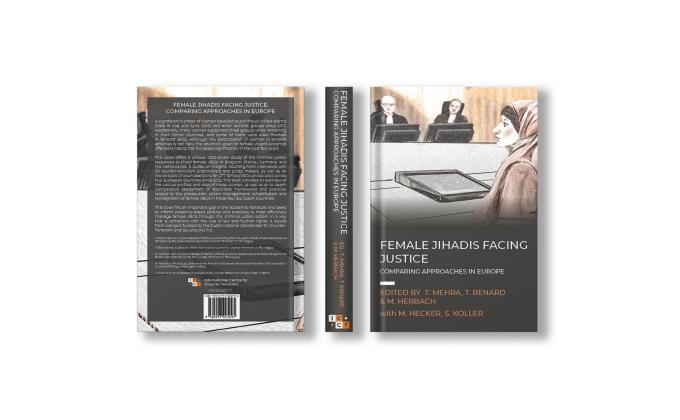A significant number of women travelled to join the so-called Islamic State in Iraq and Syria (ISIS) and other jihadist terrorist groups after 2012. Additionally, many women also supported jihadist groups while remaining in their home countries, and some of them were even involved in terrorist plots. Although the participation of women in terrorist activities is not new, these women have received more attention in the past few years. In particular, there has been a notable gap in analysis of the criminal justice response to these women.
Drawing on an unprecedented number of cases, this book focuses on jihadi-affiliated female violent extremist offenders (VEOs) in Belgium, France, Germany, and the Netherlands. Building on insights resulting from interviews with 69 relevant practitioners and policy makers, as well as on the analysis of court decisions for 277 female VEOs, this unique data-driven comparative study provides a contemporary overview of the various profiles and roles of these women. It further provides an in-depth assessment of the applicable frameworks and practices in Europe relating to the management of female VEOs in the criminal justice system, covering prosecution, prison management, rehabilitation, and reintegration.

The full table of contents is available here.
A paper copy of "Female Jihadis Facing Justice: Comparing Approaches in Europe" can be purchased by contacting the ICCT General Affairs Manager.
Cross-cutting Observations
-
The average age at the commission of the crimes is 24.8 years across all four countries;
-
Female VEOs fulfilled a variety of roles and conducted very different activities, whether in Europe or abroad.
-
The simplistic profile of female VEOs as “jihadi bride” was debunked in all four countries, and women’s participation was much more complex that via marriage alone.
-
Most women were affiliated with ISIS and committed the crimes in question between 2014 and 2017.
-
The women who voluntarily returned from Syria and Iraq before ISIS established its caliphate in 2014 were not as systematically investigated and prosecuted as those who returned later. Initially perceived mostly as victims, the perception of female VEOs evolved from 2015 onwards to recognise their role as perpetrators.
-
Except for the women who were involved in plotting attacks, those who did not travel to the conflict zone received shorter sentences that those who did travel and later returned.
-
The vast majority of the women had no previous criminal record, which is a significant difference to male VEOs where previous criminal history was more common.
-
Gender-specific aspects are frequently taken into account as mitigating and aggravating factors during sentencing.
-
The number of female VEOs in prison has increased significantly over the past years, whereas the number of male VEOs has decreased, hence changing the gender-balance in prison contexts.
-
Female VEOs are largely managed through the same prison regimes as male VEOs, although important adjustments were operated in the past few years as a result of the growing influx of female returnees.
-
Gender-sensitive, rather than gender-specific, prison management as well as rehabilitation and reintegration efforts pay special attention to the needs and vulnerabilities of women, for example as mothers, and are being applied.
-
Prison staff generally perceives female VEOs as “good inmates”, who demonstrate a lower risk of physical violence and radicalising or recruiting other inmates.
-
False compliance in rehabilitation and reintegration efforts remains a concern, especially in cases of female returnees, but can be mitigated through monitoring in prison and through multi-stakeholder consultations exceeding imprisonment.
-
Female VEOs have not yet posed a particular risk of recidivism, although some remain ideologically committed in prison and after their release.
Belgium
- Belgium has prosecuted a large number of female VEOs over the past decade, with at least 58 percent of them being returnees and at least 42 percent non-travellers.
- Female VEOs are predominantly prosecuted solely for membership in a terrorist organisation.
- Deprivation of nationality is increasingly being applied against convicted female VEOs.
- Trials in absentia are frequently conducted in cases of female VEOs who remain in Syria, leading to higher prison sentences than trials conducted in presence of the defendants.
- Female VEOs are spread across different prison facilities and have not yet posed physical risks or a risk of radicalising other inmates.
- There have been a few cases of terrorist recidivism among female VEOs in Belgium, although the risk is considered to be low.
France
-
France has prosecuted a large number of female VEOs since 2017, with at least 26 percent of them being female returnees and at least 74 percent being non-travellers.
-
87 percent of the female VEOs were convicted for membership in a terrorist organisation.
-
The involvement of women in the planning of attacks in France has significantly changed the perception of women involved in terrorism, highlighting their potential risk.
-
Prison sentences for female VEOs are on average longer in France, compared with neighbouring countries.
-
Since 2021, France has developed new capacities to evaluate and manage female VEOs in prison, largely mirroring the approach developed for male VEOs.
-
The central disengagement programme for violent extremist offenders has no gender-sensitive approach but acknowledges the needs of female clients, which made around one third of the individuals who underwent the programme since its start in 2017.
Germany
-
The majority of female VEOs prosecuted in Germany are returnees.
-
Based on individual assessments of maturity and context, juvenile justice is also being applied in cases of alleged perpetrators who were older than 18 years old at the time of the commission of the crimes.
-
Female VEOs are increasingly being prosecuted for core international crimes, including their involvement in the genocide of Yazidis as well as for domestic offences, especially those affecting their children.
-
Organising appropriate arrangements for female VEOs to stay in contact with their children remains a key concern for the different prisons where female VEOs are incarcerated, as around 91 percent of the female VEOs in detention in Germany are mothers
-
There is a wide range of governmental and non-governmental services supporting female VEOs in rehabilitation and reintegration, however, many suffer from a lack of coordination and funding.
Netherlands
-
The majority of 68 percent of female VEOs prosecuted in the Netherlands are returnees.
-
Some female returnees are now being investigated for core international crimes in addition to terrorism charges.
-
Deprivation of nationality and no-entry ban and return decisions pose challenges to rehabilitation and reintegration and can have human rights implications for the female VEOs and their families.
-
Female VEOs are detained in special terrorism-offender prison facilities, with new specific capacities developed since 2020.
-
Sentencing judges frequently order a variety of special probation measures, including religious counselling, contact restraints, and living arrangements.
-
Courts can order mandatory rehabilitation and reintegration measures during sentencing, the most frequently applied measures are reporting duties to the probation service, regulations on living arrangements, and psychosocial counselling which was each ordered in fourteen cases either in addition to each other or in combination with other measures.
Recommendations
Based on our research, building on a unique dataset and on a large number of interviews with stakeholders across four European countries, we formulated nineteen specific recommendations, aimed to inform what evidence-based policies and practices in the management of female VEOs. Some of these recommendations are highlighted below:
-
States should invest in increasing the capacity and expertise to prosecute for core international crimes, including sexual- and gender-based violence crimes. This means adequate staffing and training of prosecution and investigation services. Additionally, policy makers and prosecutors need to invest in inter-agency coordination, to facilitate the identification and use potential evidence. Cooperation should happen both between national agencies and on an international level, through fora where experience and knowledge can be exchanged.
-
Trials in absentia have only a limited impact when it comes to achieving full accountability. Thus, they should only be pursued with respect to fundamental safeguards. Similar safeguards need to be in place when depriving VEOs of their nationality. This should be done restrictively on a case-by-case basis by an independent judge, taking the personal circumstances into account and providing for sufficient remedies; also in relation to potential no-entry bans or return decisions.
-
The prison management of female VEOs should adapt specific security measures on risk assessment and categorisation of inmates. This should be done through proper risk-assessment tools and practices, with particular attention to potential gender-specific risks, vulnerabilities, and needs.
-
Continuity of rehabilitation and reintegration programmes throughout the prison-exit continuum must be established. Ensuring that probation officers already establish contact with the female VEOs before release, can be helpful to build trust and ease the post-release monitoring.
-
Close monitoring of female VEOs after their release is essential (especially in the first months, when the risk of recidivism is higher), as they could potentially continue to engage with extremism or terrorism.
The authors and the ICCT are grateful for the financial support received from the Dutch National Coordinator for Security and Counter-Terrorism (NCTV) for this research.











